Creating engaging , welcoming and playful learning spaces for babies and toddlers is just as important as setting up environments for older children. However, I know that sometimes this is easier said than done and educators can struggle to find the right balance between offering an environment that is developmentally appropriate and yet still allows for both security and basic caregiving needs to be met alongside the freedom of exploration as they challenge and extend upon new skills.
Why is designing a playful learning space for babies and toddlers so important?
We know that babies and toddlers tend to learn and adapt best in environments where they can form secure, trusting relationships with caring and responsive adults, where they always feel safe and a sense of belonging. It can be challenging to work and plan for this age group as they require close supervision, positive guidance and stimulating experiences while they feel their way through a period of very rapid growth and change.
Anyone who has spent time with this age group will know how easy it can be to feel overwhelmed with the constant cycle of just meeting basic comfort needs like nappy changes, feeding, bottles, naps and sleep times and yet there is also pressure to include additional ‘learning' activities and experiences. Instead of trying to ‘do more' and ‘program more' though why not first focus on the actual environment – the ‘bones' of the spaces baby and toddler will spend the majority of their time while in care.
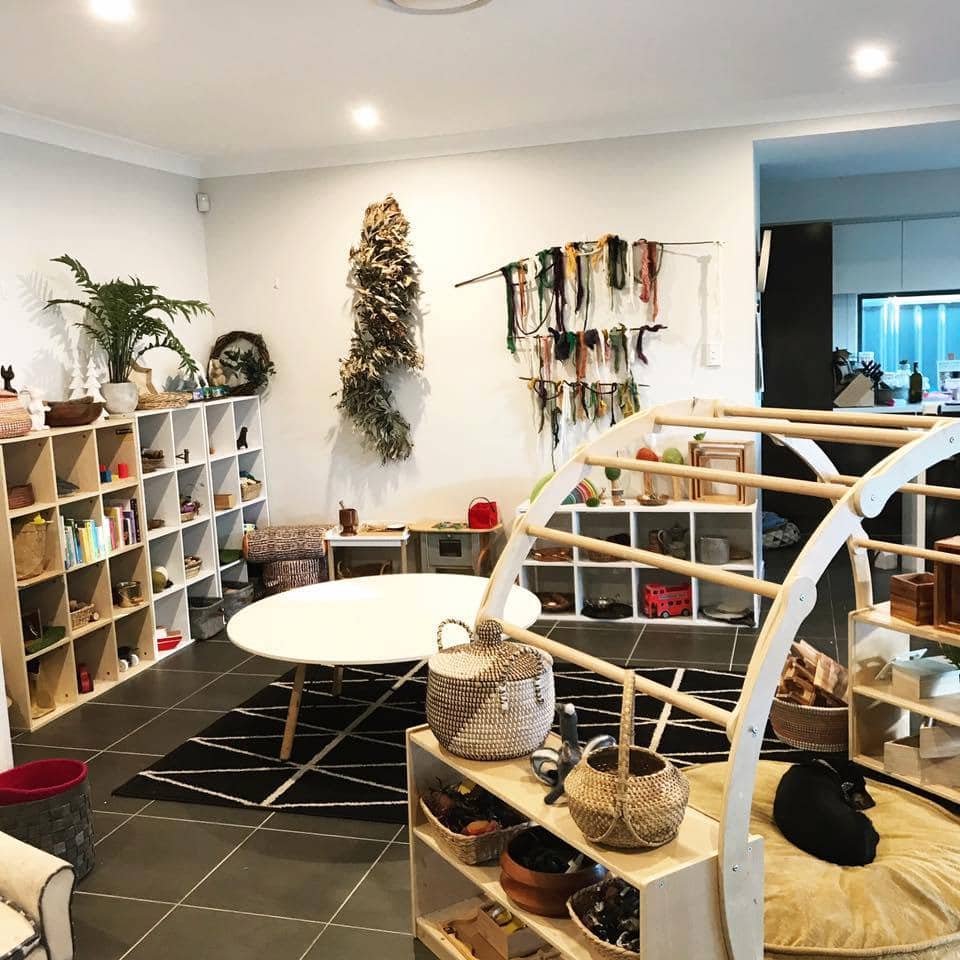
Shared by Clare Louise – The Woodland Child
A well thought out and set up room can actually make things easier from the start by incorporating both the necessities and needs of daily care and security as well as providing the flexibility and freedom this age group needs to explore and build upon emerging developmental skills.
This age group does not need a program template filled with new and different creative activities every day – they just need an environment that supports their unique needs and provides the security of regular educators they can connect and bond with. The learning will follow so I encourage educators working with babies and toddlers not to get so stressed about planning the perfect activities while also trying to fit in the endless cycle of nappies, sleeps, feeds and vomits!
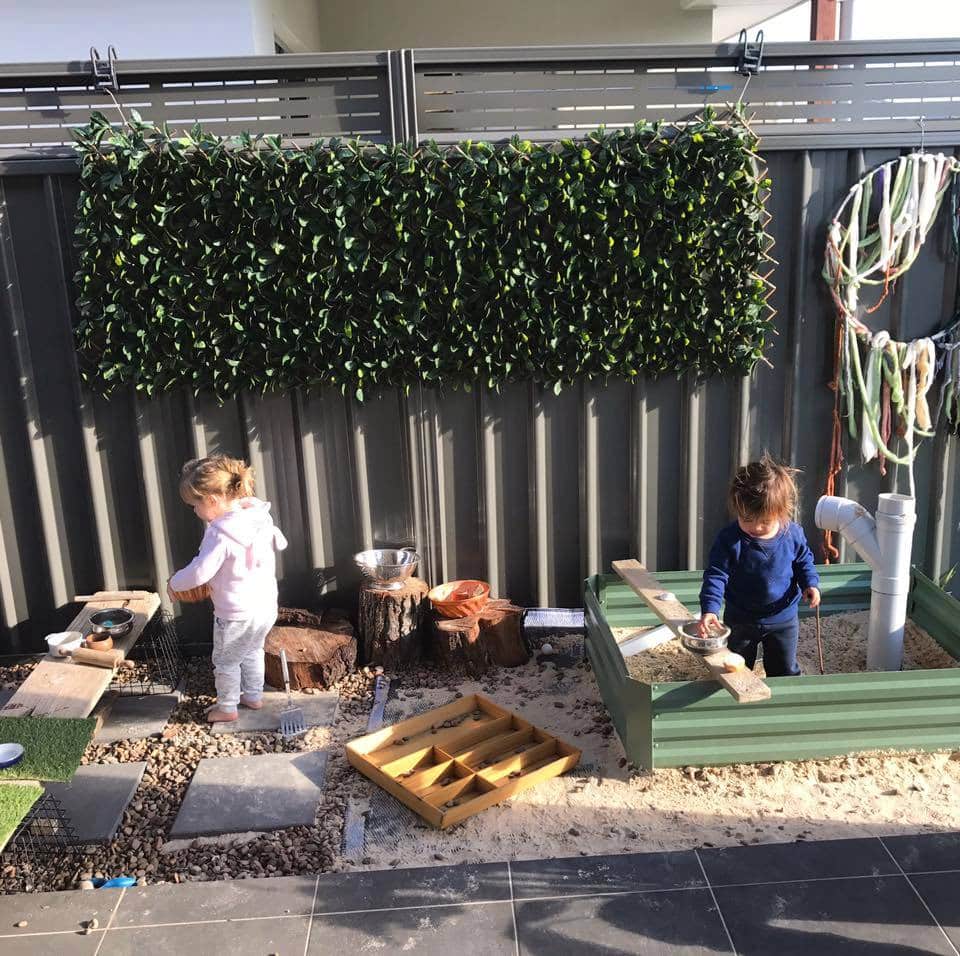
Shared by Clare Louise – The Woodland Child
This age needs to be approached a little differently – especially if you are used to planning and creating spaces for 2.5 years up but it can also be so rewarding as you get to nurture and guide those first learning steps and watch little personalities emerging.
Yes there will be the time you walk into the cot room and there is a lovely drawing on the wall in poo or you will find yourself always needing a second shirt change after lunch because the sick smell you thought was following you IS you. And there will be days where everyone just seems to want to cry (including you) and the paint activity you lovingly prepped ends up in the toddler potty as you change yet another nappy….but there will be wonderful, special moments too and you can take a lot of the pressure off just by putting a little thought into how you can set up the best possible environment to meet both the baby and toddler needs as well as the adults!
To help get you thinking about your own environment I'm sharing some simple strategies and ideas to consider as well as loads of visual inspiration from real educators just like you! Remember that everyone is different though with access to different budgets, resources, service types and space so don't feel you have to recreate the spaces throughout this article, just take an idea or element here and there that you would like to embrace or use. Small steps help make change….
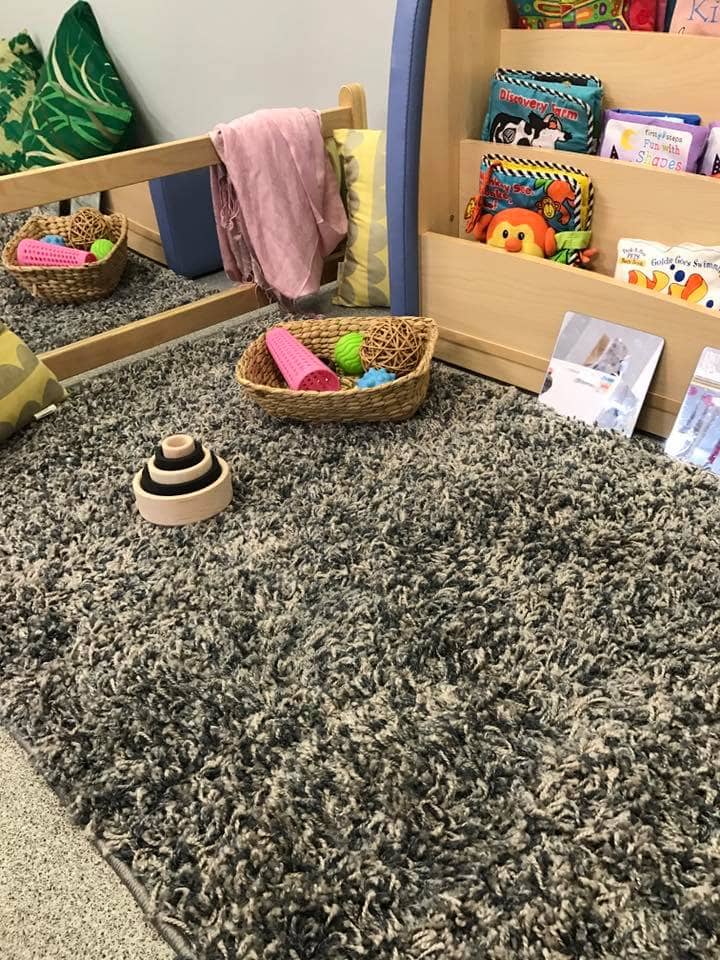
Shared by Nicole Hall – Sparrow Early Learning
First Steps – Essentials to consider in a Baby/Toddler Environment
Environments can affect the behaviour of both the child and the educator so it is important to put a little time in at the beginning of each month or week to assess current developmental needs, stages, verbal and non verbal cues,new children, relationships and space …then make changes as needed. This will make things a whole lot easier as you progress and also provide opportunities for ongoing reflection and planning.
Before you convince yourself this is all going to be to difficult though let's take a quick look at some of the absolute essentials I believe you should consider and reflect upon when thinking about setting up spaces for this age group.
- Are you approaching the space with the possibility of it becoming the ‘third teacher' rather than just a place to change nappies, feed and sleep?
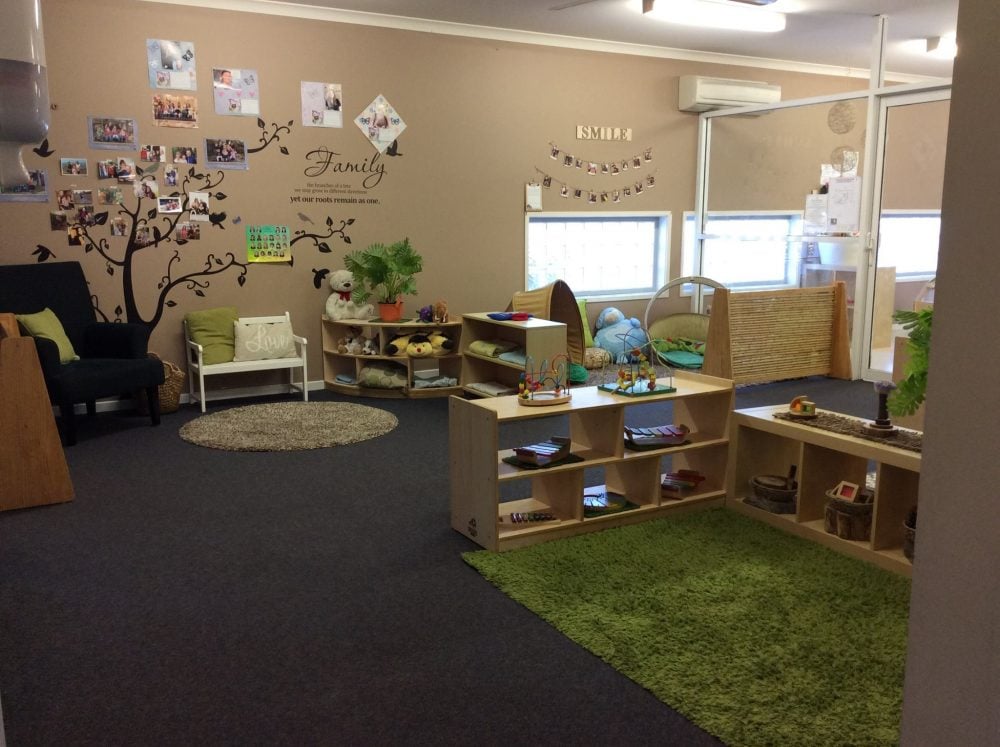
Shared by Sarah Hart
- Take a close look at the current furniture being used – is it safe and hygienic as well as welcoming?
- Is there plenty of open space for baby to roll around, pull to stand, cruise or practice first steps? Think about ages and stages currently occupying this space whether in a family day care or centre environment.

Shared by Amy Crombie – Capalaba Kids Early Learning Centre
- Is there the security of familiar and regular educators, furnishings and also simple activities that support and encourage confidence, trust and a willingness to explore and learn?

Shared by Rebecca Wilson
- Are there safe yet interesting spaces set up around the room that allow for different ages and stages to explore, try out ideas and actions on their own? Have toys and materials been provided that allow for open ended play, discovery and learning?

Shared by Sarah Hart
- Is there a good selection of resources set up throughout the room for baby and toddler to make their own choices and decide how they will explore and play with those tools rather than an excess of toys that have a ‘right way' to play or be used?

Shared by Clare Louise – The Woodland Child
- Are toys and other activity resources displayed so they are easily accessed by the different age groups yet not to crowded or overstimulating?

Shared by Sarah Hart
- Do educators incorporate and reflect an understanding of family and community culture into the environment in various ways to help children feel a sense of connection and belonging to the space?

Shared by Sarah Hart
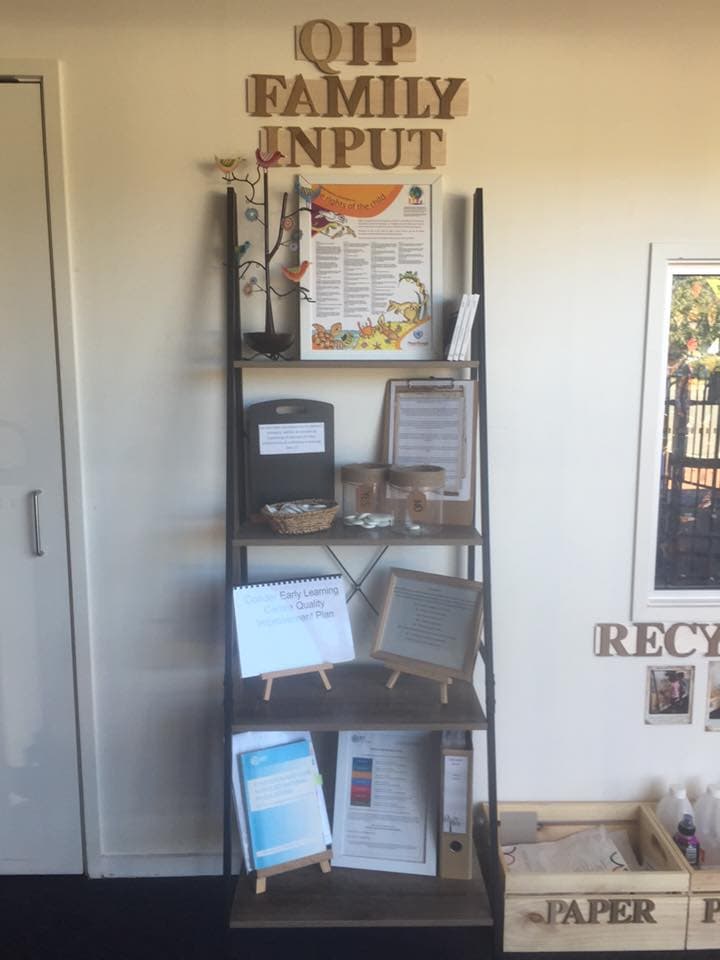
Shared by Sarah Hart
- Have educator needs also been considered? Are spaces and furniture incorporated that support these needs as working with babies and young toddlers can be particularly draining and challenging on the body and mind! Consider availability of comfortable adult sized chairs for feeding, lockers or high shelf spaces for personal items, spaces to take a quick breather, steps for toddlers to walk up for change table time to save back muscles, efficient food and bottle warming equipment.
- When educators feel their personal wellbeing and sense of belonging is being considered and supported this has a flow on positive effect and benefit on the babies and toddlers in their care.

Shared by Janelle Duncan – Curious By Nature Family Day Care
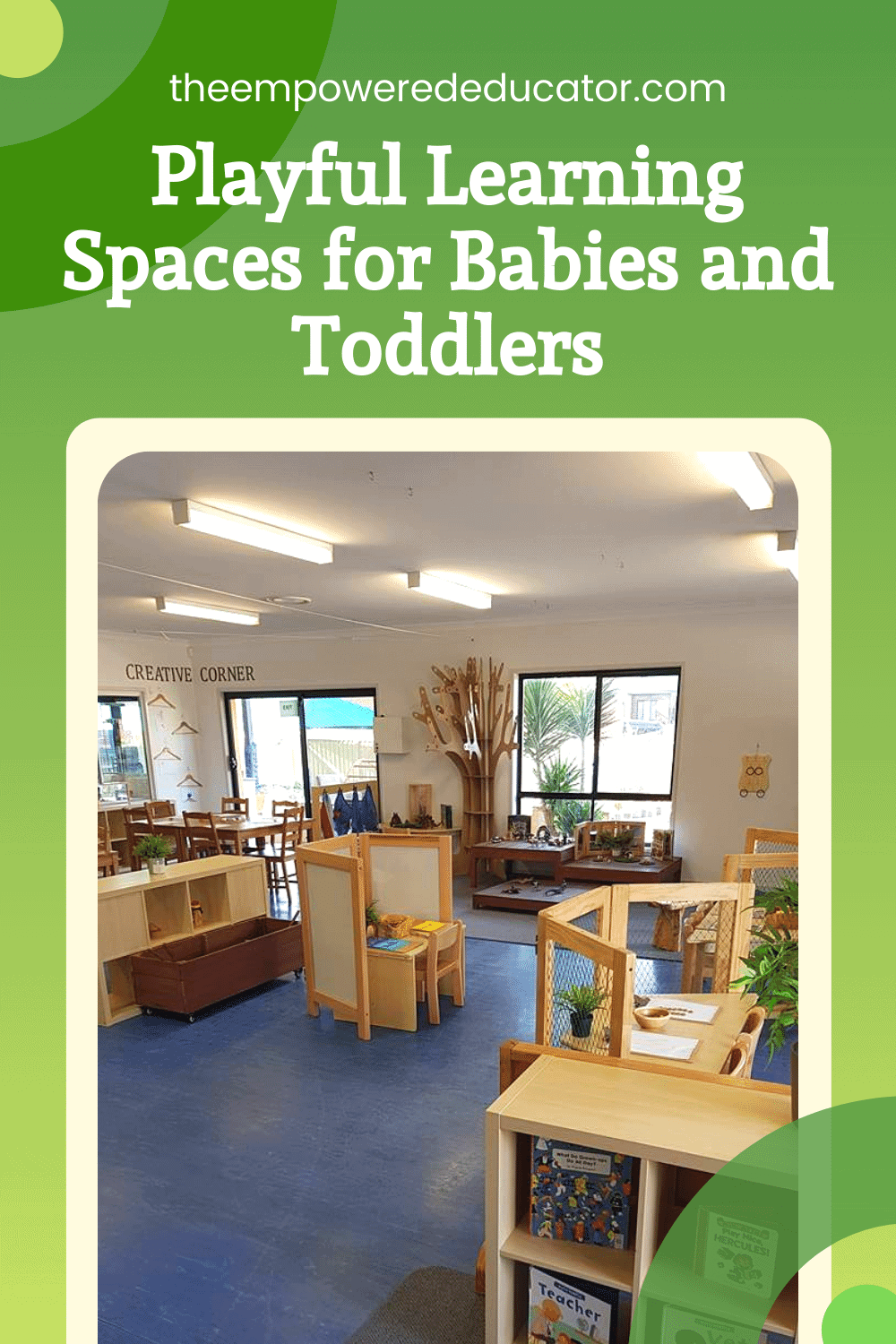
Action Steps to help you design playful learning spaces for baby and toddler.
When thinking about creating new spaces for babies and toddlers or reinvigorating current learning areas reflecting upon the following considerations will help you to identify where you might need to start and the materials and resources you need to make it happen. Remember that the process is ongoing so you can take small steps towards a big change – there is no need to let it overwhelm you.
- Take regular observations of children currently in care to gain a through understanding of their likes, dislikes, individual needs, strengths, developmental requirements and family culture.

Shared by The Empowered Educator
- Get down on the floor regularly to view the learning environment from the perspective of a baby and toddler because you might be surprised at what you discover. Often we create a space that we feel is meeting needs and yet when we put ourselves in the children's shoes it's a different story!

Shared by Clare Louise – The Woodland Child
- If you work with other team members discuss wellbeing requirements, needs and wishlists.
- Think about storage and how to incorporate different textures, smells, home comforts, nature and soft furnishings alongside hygiene requirements and essential nurturing spaces.

Shared by Sarah Hart

Shared by Sarah Hart
- Consider lighting and explore alternatives to harsh bright lights that can overstimulate. Perhaps incorporate lamps, downlights, lampshades or material draped to soften where possible.

1. Shared by Sarah Hart
2. Shared by Poppy Kerakas
3. Shared by Poppy Kerakas
4. Shared by Rochelle Hesketh
- Is there always music playing in the background that has become simply ‘noise'? Music is a wonderful addition to play spaces but consider how it is adding to atmosphere and being used. It can become an annoying drone that just adds to overstimulation if always on with no real purpose.
- Is there a toy rotation system in place so the room isn't crowded with the same toys and activities week after week leading to boredom, frustration and other challenging behaviours?

1. Shared by Sarah Hart
2. Shared by Vicki McDonald
3. Shared by Poppy Kerakas
- Are changing developmental needs being observed and taken into consideration at the end of each week before planning ahead?

4. Shared by Sarah Hart
5. Shared by Sarah Hart
6. Shared by Poppy Kerakas
- Is there space to move around and greet families and children as they come into care and transition?

Shared by Sarah Hart

Shared by Sarah Hart
- Are the nappy changing and toilet training spaces well thought out with room to store items and individual belongings safely and hygienically while maintaining a home like environment rather than a sterile hospital change room atmosphere? Is the space setup to be used as another area to encourage learning and trust rather than just meeting basic physical needs?

Shared by Sarah Hart
- Is there provision for quiet spaces as well as active spaces? Are children able to retreat somewhere safe if sensory overload becomes an issue or privacy is required or alternatively get active and noisy?

Shared by Sarah Hart
- Is display used throughout the environment respectfully to share children's work and progress with family while also helping to provide a sense of connection for baby and toddler? Are there displays, images, special objects and homely touches placed often at the children's level to help reinforce that they are welcome and part of this space?

Shared by Sarah Hart
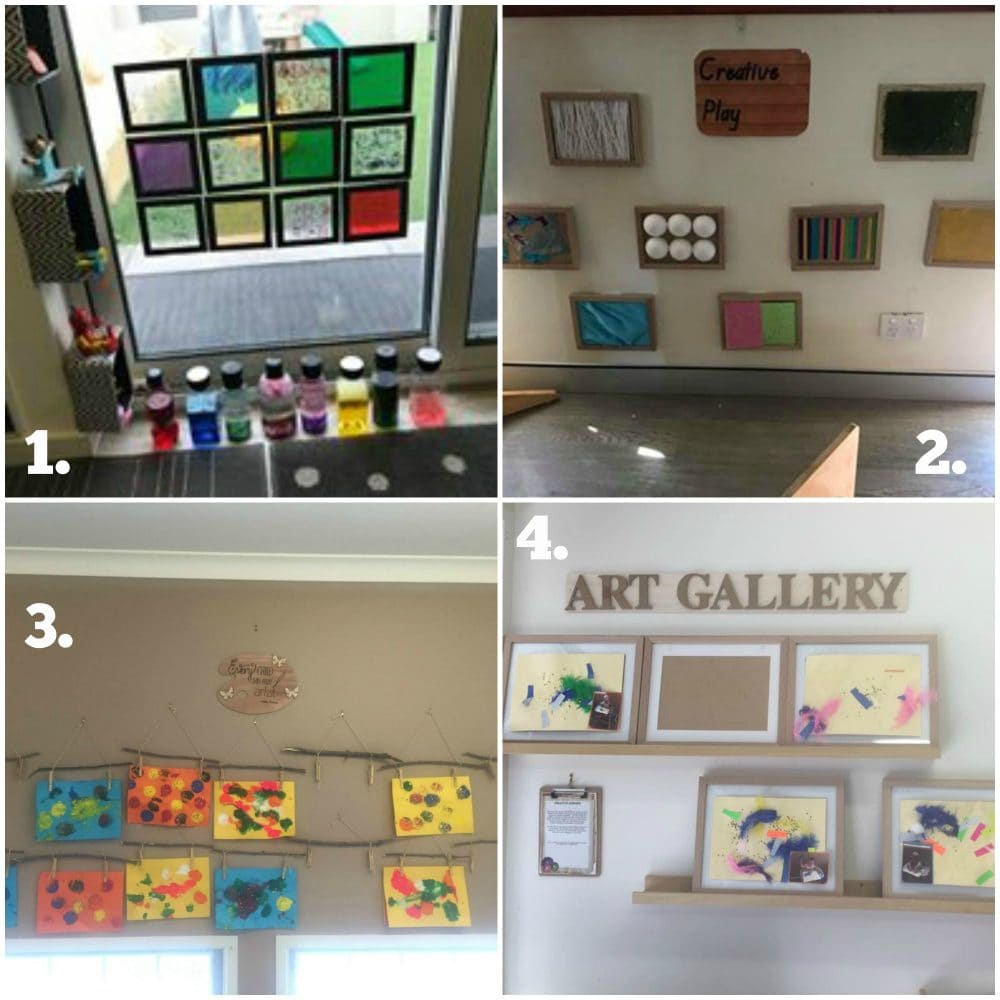
1. Shared by Abigail Brown – Learning Through Play Family Day Care
2. Shared by Jessica Woodhead
3. Shared by Sarah Hart
4. Shared by Sarah Hart
- Is the environment (and the educators) flexible enough to allow for the differences between fast changing skills, interests, and characteristics? Are there safe spaces for babies not yet moving but more challenging spaces for older babies and toddlers to explore?
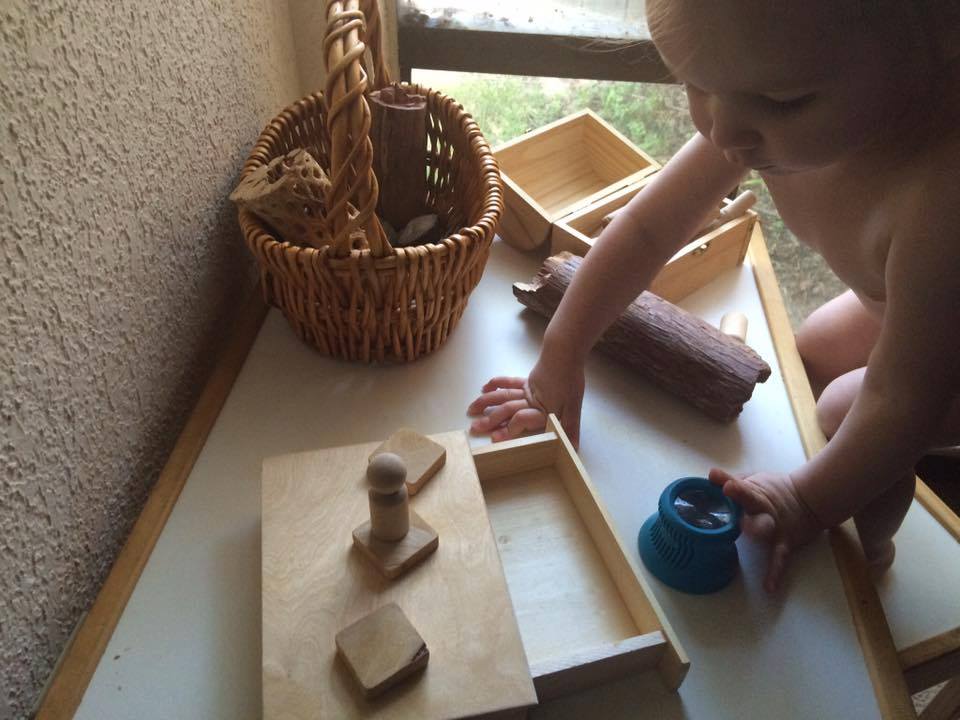
Shared by Kristina Conner – Tina's House Daycare
- Is there an overuse of bright colours, images and display that might be overwhelming every day? Neutral paint colours and furnishings often provide a calmer atmosphere and help create a warm homelike feel that promotes a sense of security and confidence.

Shared by April-Louise – Little Achievers Family Day Care

Shared by Sarah Hart
- Are separate areas within the learning space set up to embrace different requirements such as quieter spaces near the cot room, creative and messy spaces near the change or toileting area, feeding and eating spaces for both babies and more independent toddlers close together (especially useful when educators are trying to simultaneously bottle feed a baby while also spooning in mashed vegies to a tired toddler!)

1. Shared by Sarah Hart
2. Shared by Sarah Hart
3. Shared by Tiffany-Ann Louise – Little Rays of Sunshine Family Day Care
4. Shared by The Empowered Educator

4. Shared by The Empowered Educator
5. Shared by Carelene Cox-Newton – Carlene's Cubbyhouse Family Day Care
6. Shared by Sarah Hart
7. Shared by Janelle Duncan – Curious By Nature Family Day Care
Getting Started with Learning Spaces – Simple Ideas to try
I love to incorporate smaller individual areas within a room to provide plenty of opportunities for different learning experiences and exploration. It also helps keep boredom and frustration at bay and supports young children to challenge, experiment and problem solve.

Shared by Clare Louise – The Woodland Child
However, although designing smaller spaces to encourage play and learning in different ways is usually helpful it is important to keep in mind that you aren't seeking to contain the play to just those designated areas – children should be encouraged to freely move materials and resources from one area to another and use them in their play in different ways so they feel a sense of ownership and in charge of their own learning. We want to provide an environment that supports them to experiment, challenge, problem solve, communicate, explore ideas, make sense of their world and create with different materials.

Shared by Josephine Lorna Rayner
It is important that educators have a good understanding of the children's ages and needs interacting in the learning space at all times because this should determine how to break up the environment and if there actually needs to be more open learning space due to younger babies in care. It should be ever evolving as long as the basics we discussed above are already in place to form the ‘bones' of the learning area. There are no rules as to whether creating smaller areas works better or not – my best advice is to give it a try, get creative after observing the needs of the children currently in your care and see what works and what doesn't.
This is where simple back to basics programming and planning comes in. Use observation and regular reflection to identify needs and goals and think about how you can plan for this using the playful environment and third teacher perspective rather than just what ‘activities' or learning outcomes you can tick off.

Shared by Sarah Hart
Not sure what spaces to try and create within the larger environment? Go back to the questions above and work your way through the First Steps and Action Steps this time writing down your answers. Think about what you have discovered through your answers then get started designing and creating the play space with a few of the easy ideas below…
Soft, Cozy, Comforting Spaces for those that need alone time, privacy or time to process sensory overload. Think floor cushions, blankets, rugs, draped material to form enclosed safe spaces. This area can also incorporate or align closely with a book nook and language area.
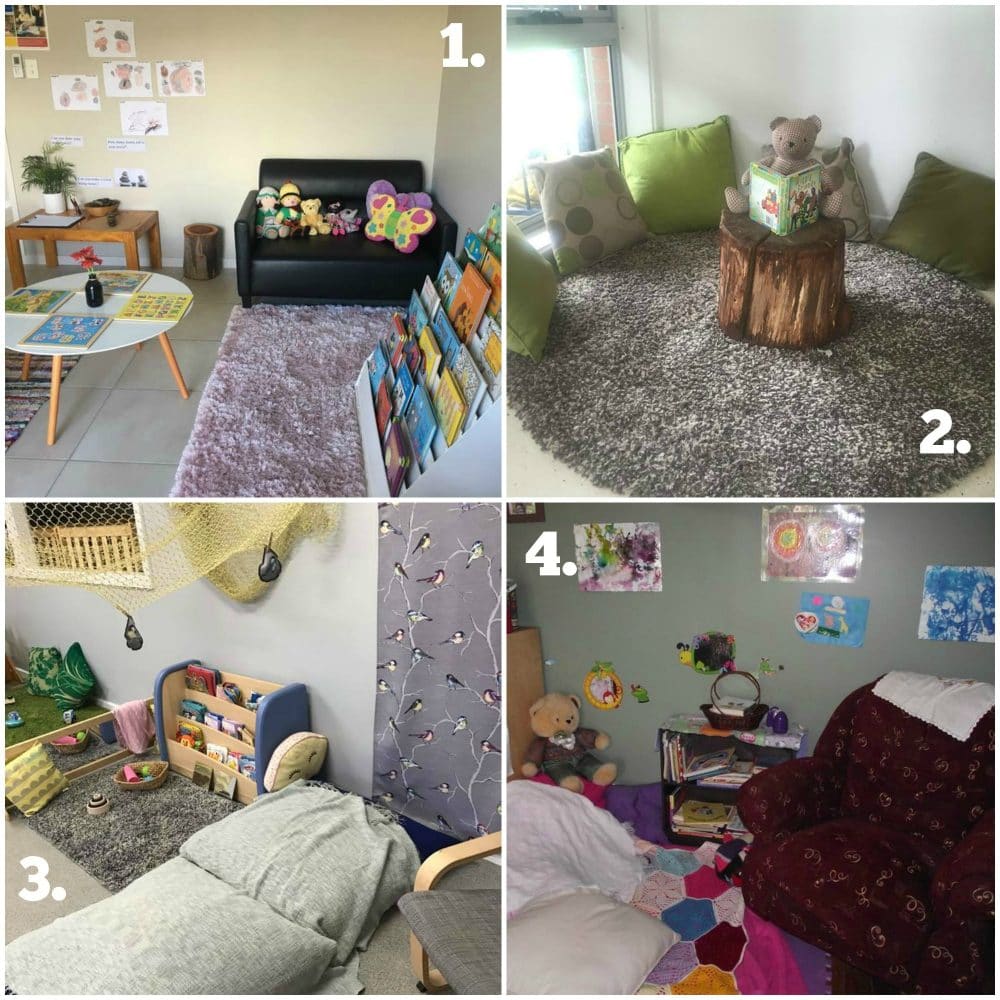
1. Shared by Tiffany-Ann Louise – Little Rays of Sunshine Family Day Care
2. Shared by Sarah Hart
3. Shared by Nicole Hall – Sparrow Early Learning
4. Shared by The Empowered Educator
Gross motor/climbing/physically challenging spaces with various loose parts, stairs, wooden cubes for climbing through and over, ladders, platforms, uneven surfaces, texture, tunnels…

1. Shared by Josephine Lorna Rayner
2. Shared by Sarah Hart
3. Shared by Rebecca Wilson
4. Shared by The Empowered Educator
Space for Younger Infants set up with different materials to grasp, kick and reach for while still providing enough space to roll around. Keep it simple – no need for expensive toys, get creative with material scraps, scrunched paper, recycled materials, repurposed furniture to create hanging spaces.

Shared by Janelle Duncan – Curious By Nature Family Day Care
Mirror and Reflection Spaces down low to explore faces, expressions and self. Displays and images on the floor and bottom half of walls for younger babies.

1. Shared by Tiffany-Ann Louise – Little Rays of Sunshine Family Day Care
2. Shared by Josephine Lorna Rayner
3. Shared by Rebecca Wilson
4. Shared by Sarah Hart
Sensory Spaces for children to explore different natural materials, sounds and smells. Provide simple tools to make music with, resources to sniff and explore with little noses, baskets filled with different textures and tools that can be taken out and investigated using all of the senses.

Shared by Tiffany-Ann Louise – Little Rays of Sunshine Family Day Care
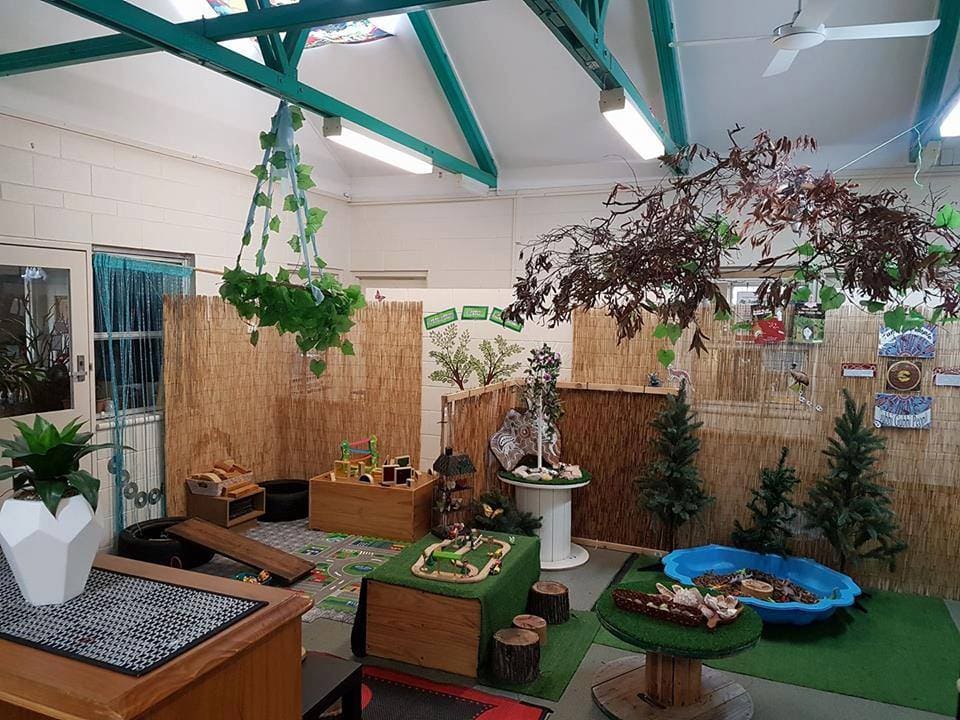
Shared by Vicki McDonald
Noisy Construction Area – A place to store building materials, loose parts to add to the play, trucks, cars, wooden blocks, larger natural materials and recycled items. Needs plenty of space to allow the spread of construction and thought processes as they create and experiment.

Shared by Sarah Hart

Shared by The Empowered Educator
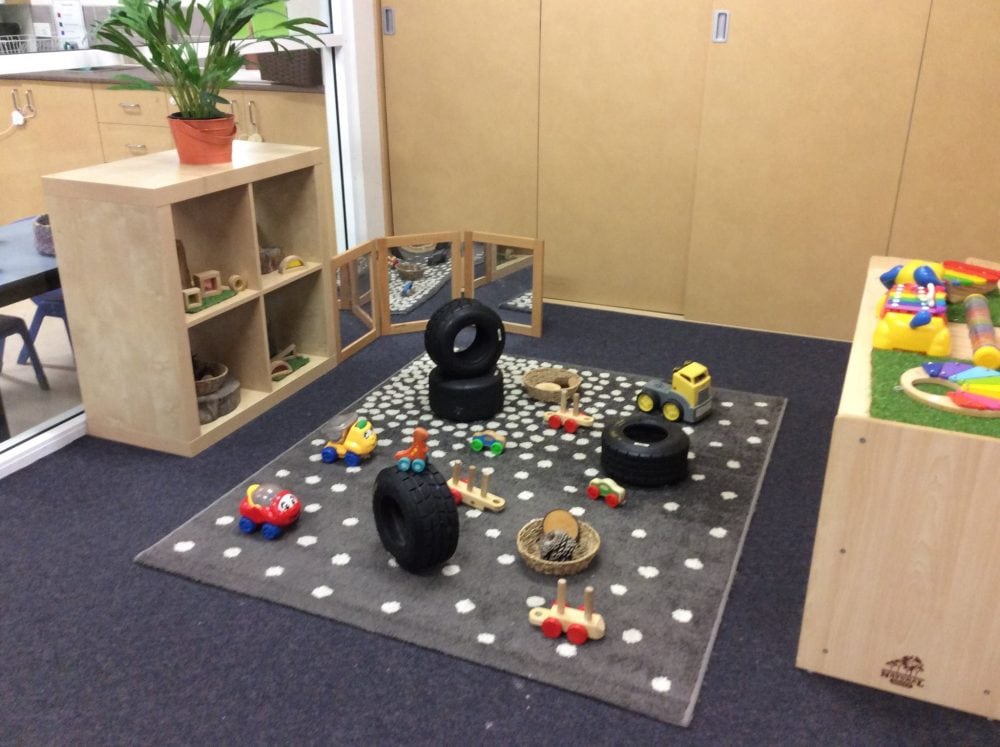
Shared by Sarah Hart
Dramatic Play Areas – Keeping it low and simple using real tools as props, familiar materials from home and real dress ups from the op shops encourages role play, language skills and imagination. It is also an area that will often keep the toddlers busy and happy doing their own thing while you attend to younger babies needs.
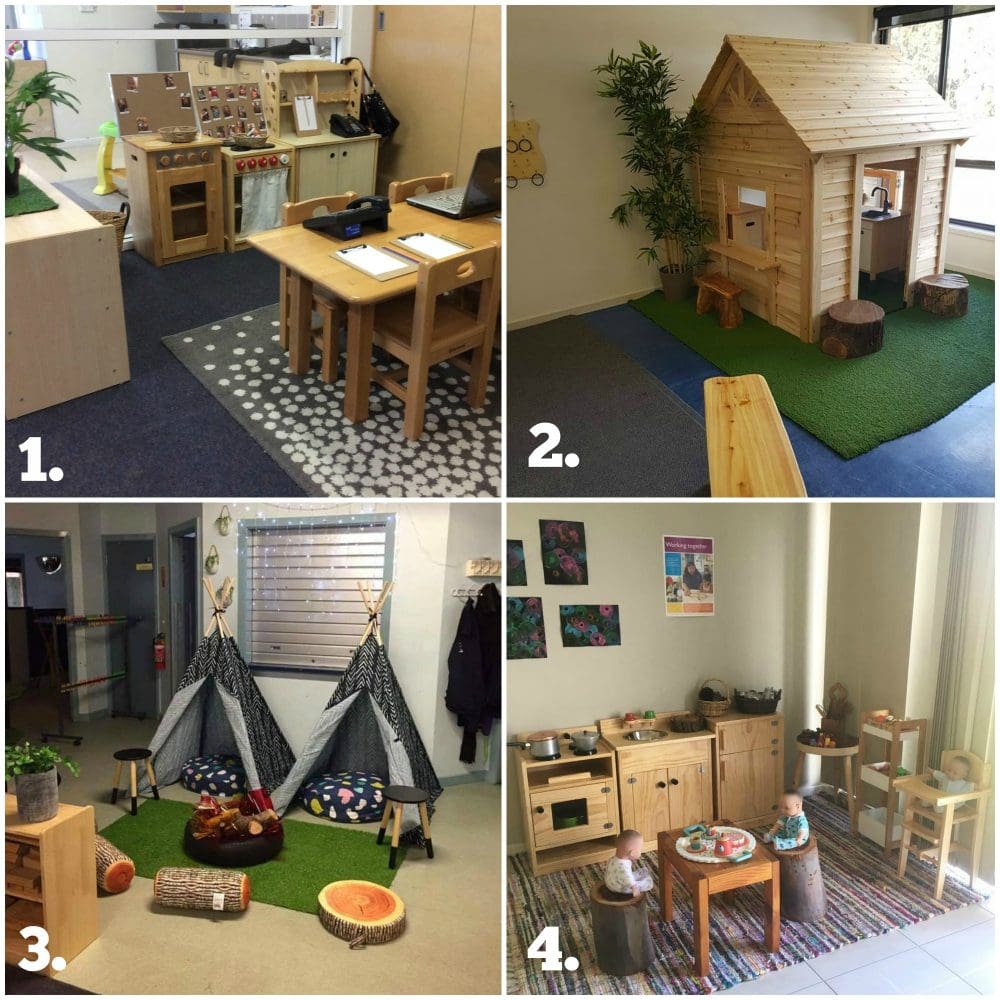
1. Shared by Sarah Hart
2. Shared by Erin Crothers
3. Shared by Jackie Wulf
4. Shared by Tiffany-Ann Louise – Little Rays of Sunshine Family Day Care
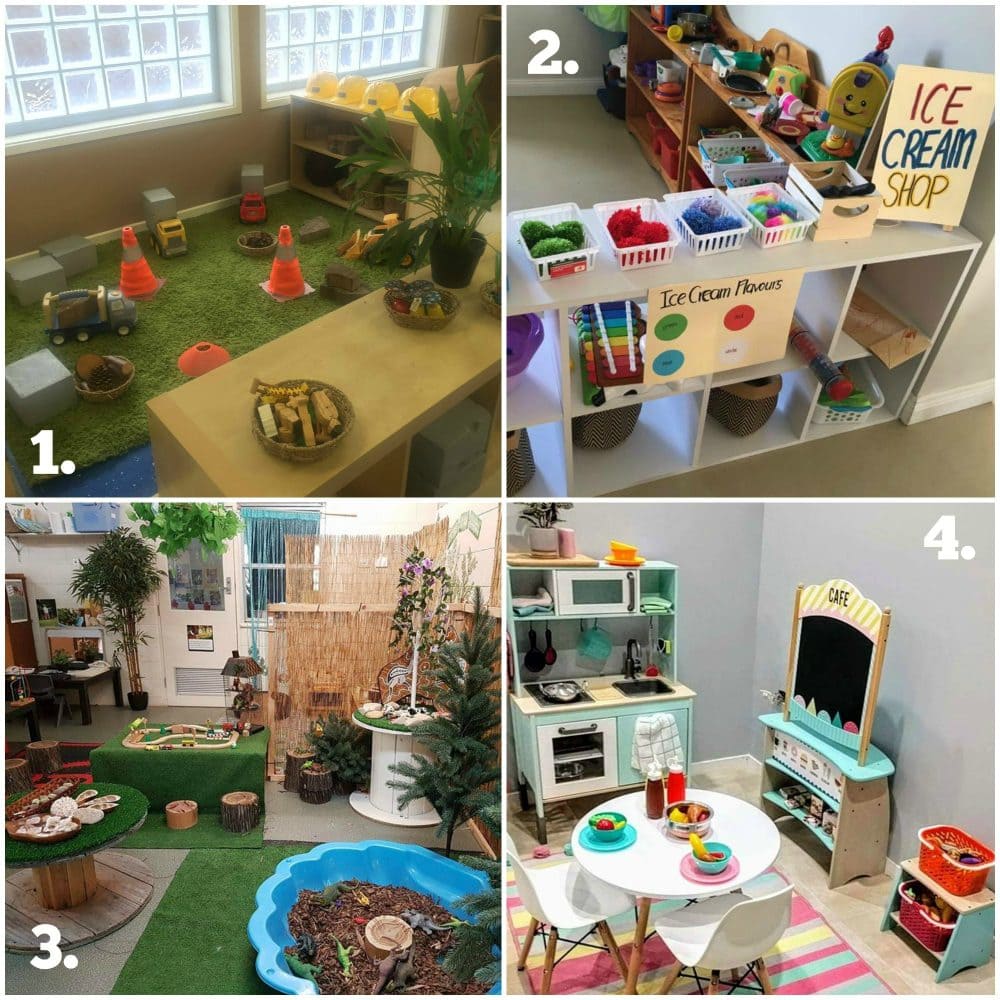
1. Shared by Sarah Hart
2. Shared by Kelly Marie
3. Shared by Vicki McDonald
4. Shared by April-Louise – Little Achievers Family Day Care
Messy Creative Play Area – Somewhere they can make mess, get busy creating, and express themselves freely using the materials you have provided. To be honest I prefer to set up messy play experiences for babies and toddlers outside because it allows the children to go back and forth between activities and play as they need to (remember they have shorter attention spans but just because they only paint for 2 minutes doesn't mean they won't want to come back another 3 times before you pack away!)
It's also less stressful for educators as you don't need to worry about the mess going everywhere inside and it's a whole lot easier to clean up and pack away while colourful hands are leaving prints on your backside! You want to encourage them to explore and get messy, not try and control every step of the experience.
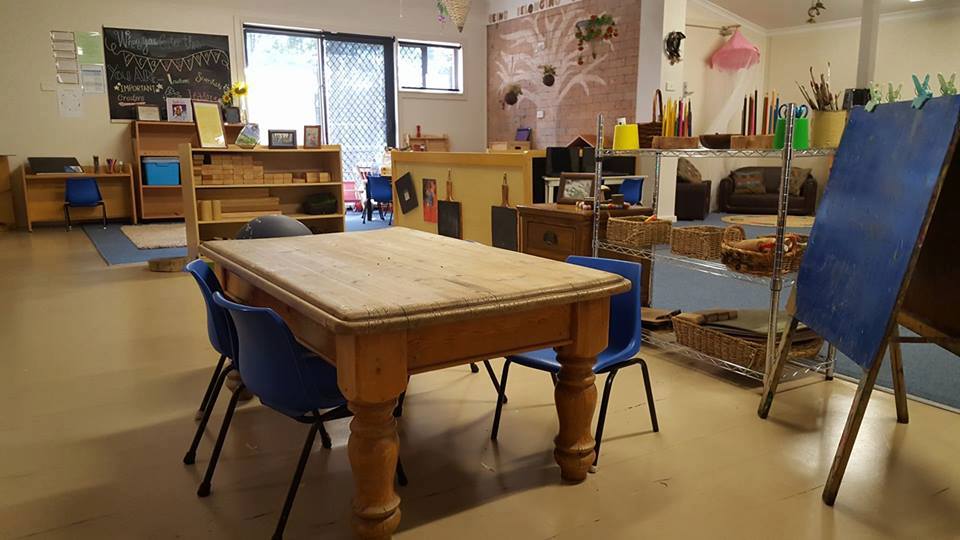
Shared by Rochelle Hesketh

Shared by Sarah Hart
Feeding and Sleep/Rest Spaces – consider supervision, ease of access, comfort, safety, hygiene, individual differences in routine, creating a sense of belonging, familiarity and home.

Shared by Sarah Hart
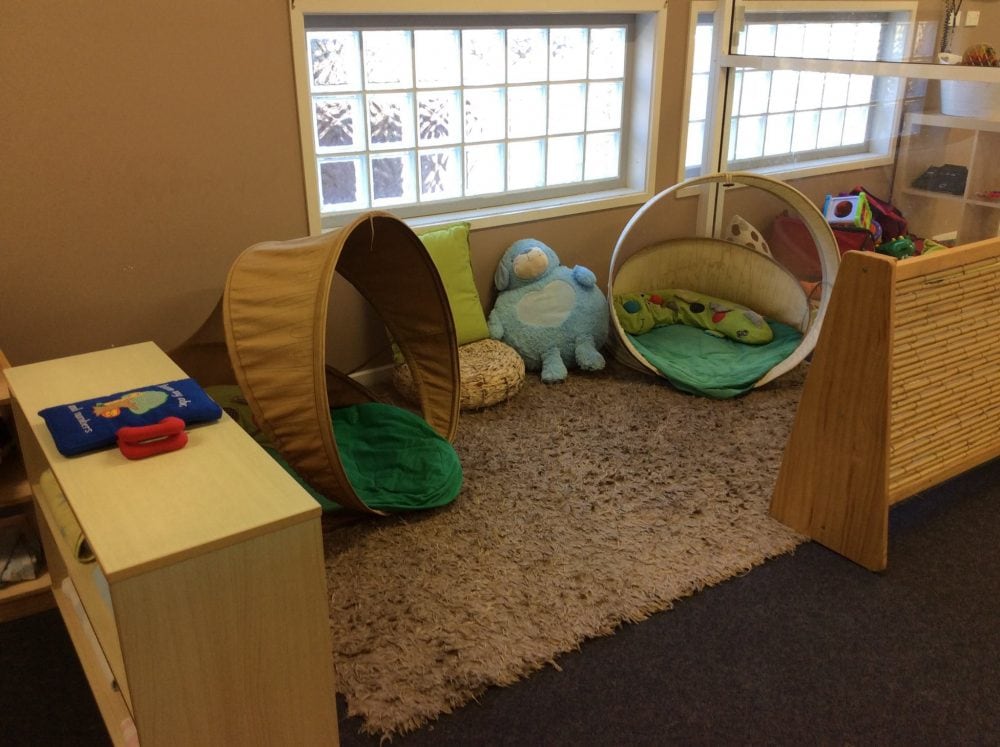
Shared by Sarah Hart
Spaces for Adults – Areas that welcome and support both parents and educators wellbeing. Easy to access educator resources for on the go documentation, reflection and handovers.

Shared by Sarah Hart
Storage Spaces – Consider options that make access, storage and pack up easy for both educators and the children. Use open shelving and keep toys and other materials in single rows with space arranged between so little hands can easily grab what they need and also see at a glance what is available. If you try and pack to much onto a shelf or into a basket it makes it difficult for a young child to make a choice and connect together the items they need.

1. Shared by Tiffany-Ann Louise – Little Rays of Sunshine Family Day Care
2. Shared by Carelene Cox-Newton – Carlene's Cubbyhouse Family Day Care
3. Shared by Abigail Brown – Learning Through Play Family Day Care
4. Shared by The Empowered Educator
Having set places and storage baskets/containers along with simple picture labels can also help with speedy clean ups and encourages toddlers to take part in helping look after their environment and feel useful as they take small steps to help clean up after themselves. Clear containers and shallow baskets also allow for easy access and a way to store smaller items that might need to be placed out of reach on certain days.

5. Shared by Clare Louise – The Woodland Child
6. Shared by The Empowered Educator
7. Shared by The Empowered Educator
8. Shared by Clare Louise – The Woodland Child
Creating different spaces and learning environments for babies and toddlers can seem overwhelming when you are not sure where or how to start but it can also be a fun creative process that in the long run will help busy educators to save time, write less, extend upon understanding of developmentally appropriate practice and and most importantly provide a safe, welcoming, challenging, nurturing and creative play space for the important little people sharing the environment with you!

Shared by Erin Crothers
Keep an eye out for the next post in this Baby and Toddler Play Series where I'll be sharing lots of simple, cost effective ideas for incorporating play materials loose parts and engaging activities into the learning environment. I will help you to think outside the box a little, ditch the plastic ‘only one way to play' overpriced resources and toys and make the most of what you probably already have!
Working with a baby and toddler age group doesn't need to feel like all you do is change nappies, feed endless mouths, settle to sleep and comfort – these things are very important but it's not your entire role so what steps are you going to take this week to make a few changes and find that missing work mojo again?

Shared by Clare Louise – The Woodland Child
Love Pinterest? – pin the image below so you can save for future quick reference!

A Little About Me
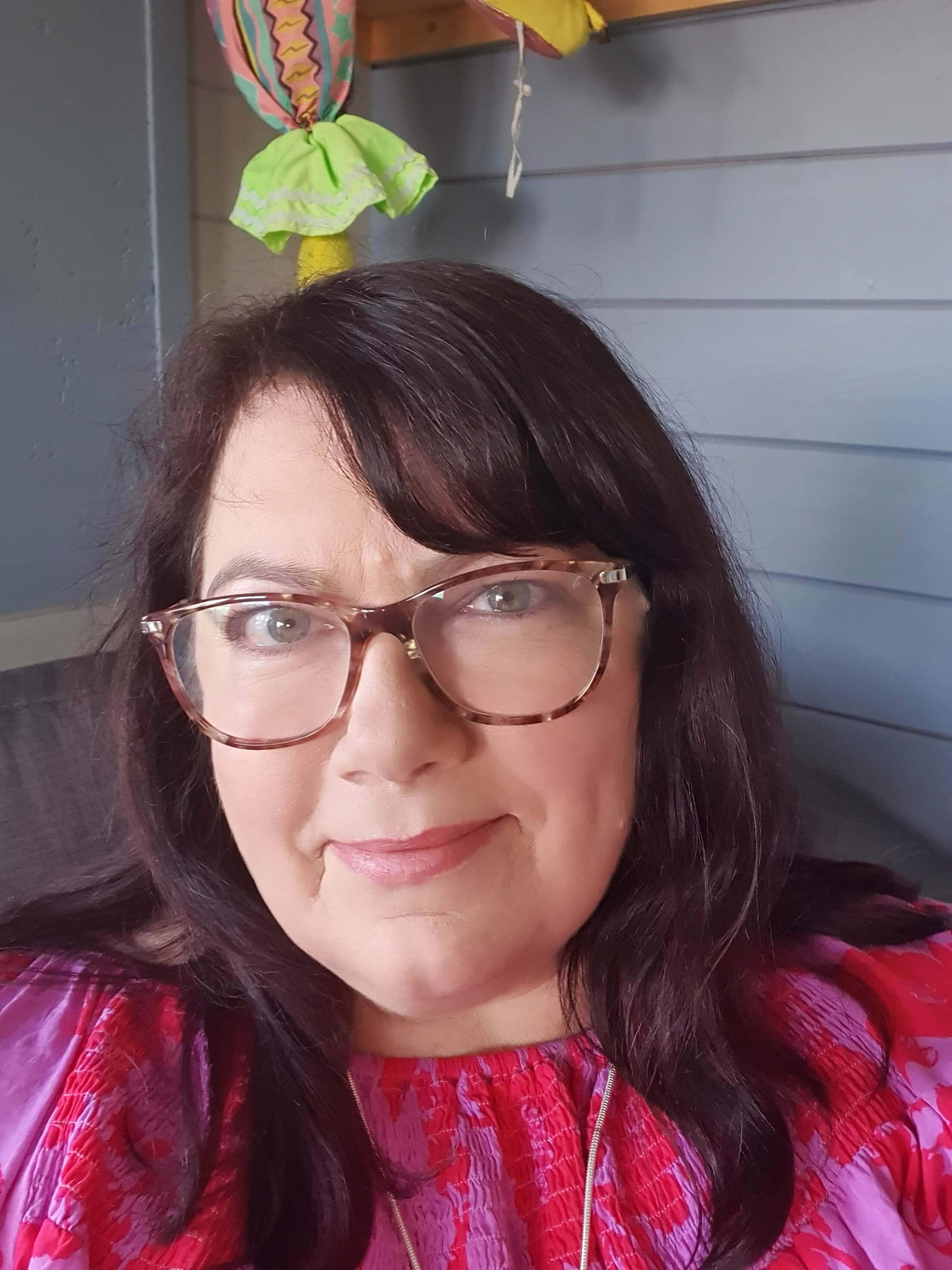
Jodie Clarke is an early childhood professional supporting educators who want and need to stay passionate about the work they do! She has 30 years hands-on experience in the early childhood and human services sectors across many different roles.
Jodie is mum to 3 in Australia and has already helped thousands of educators with their work through her popular blog posts, activity ideas, online training and e-books.
This is absolutely brilliant thank you for sharing.
Fantastic play spaces! Love the natural materials! Are most of the center based classrooms mixed ages of infants and toddlers?
Thanks for sharing activities ?
The larger rooms are mainly mixed Victoria (especially the FDC ones) but there are also quite a few just setup for infants. Glad you found them useful 🙂
Thanks for the feedback Pam!
I am interested in the setting up of the “adult spaces” in the environment. What all is included in the family feedback and space for adults pictured here? I believe they are from Sarah Hart – is there a way to get samples of what is shown? I’m teaching a class and this blog is a beautiful example of best practice! Thank you!
Loved reading through you post, thanks for the great ideas
Amazing ideas. I am keen for my staff to have a read anyway I can share the page rather than tag them in?
Hi Roz, glad you found the article useful. If you click on the box in the blog post you will be able to enter your email and download a PDf booklet of most of the information in the blog – then you can just email it to your staff or print. Otherwise you could just share the url of the post with them to look up?
Inspirational. Thank you for the motivation
Absolutely brilliant thanks for sharing !!
Brilliant, thank you
I love all the settings ideas and will use in my classrooms. Thank you so much
Thank you for all the great ideals.I will be useing a lot of them .
Thankyou so much. I have recently become an educator in a childcare and need a bit of guidance in what is needed and how much. I have so many ideas but need to know how to release a few at a time to see what works and what doesn’t. These basic ideas of what areas we need as a foundation are perfect.
love the ideas of infant and toddlers set up. It inspired me to try and do it in our infant and toddler room.
Thank you for sharing your page.
Very interesting and well detailed information for set up which benefitted me alot. Giving me much better ideas and more confident in setting up.
I LOVE the round floor chairs shared by Sarah Hart. Do you know what they are called or where I could find them? Thanks!